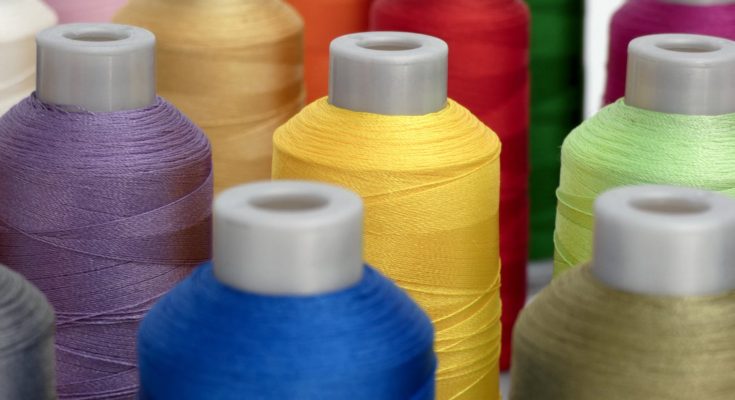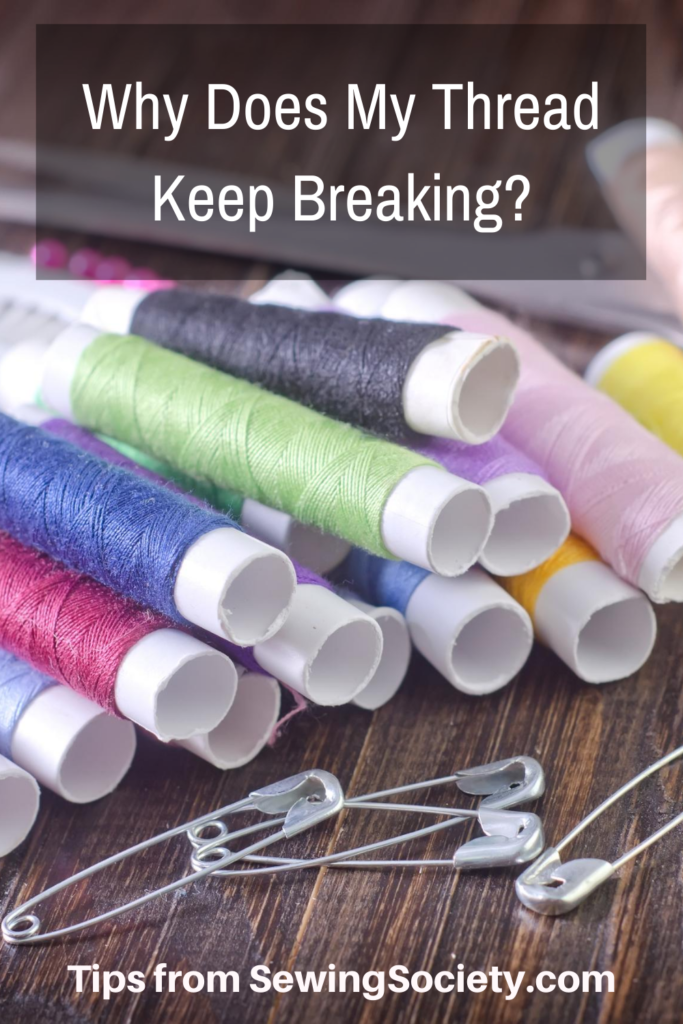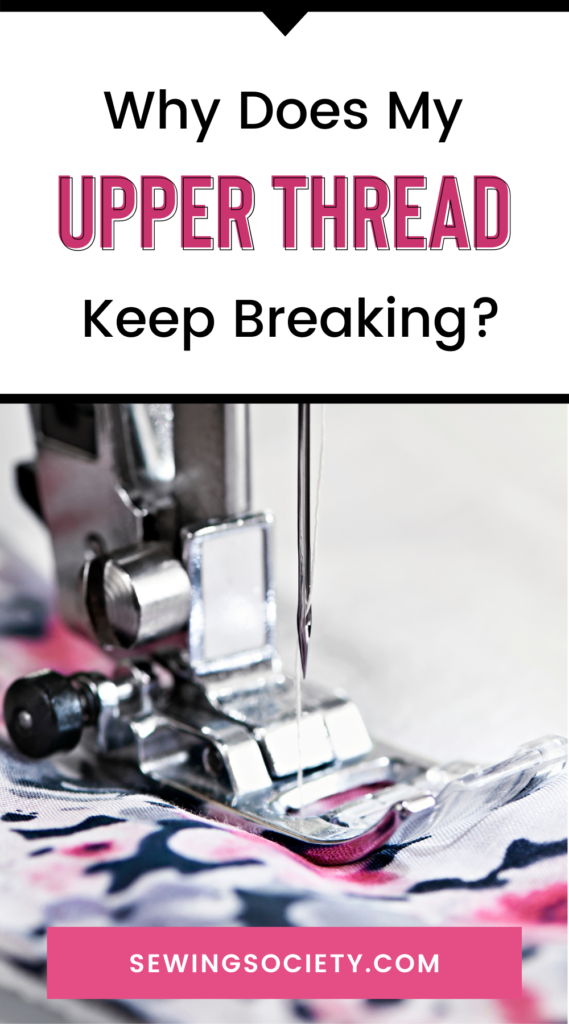Disclosure: This post may contain affiliate links. I earn a small commission when you click a link and make a purchase. Thanks for supporting SewingSociety.com!
If you’re having problems with your bobbin thread breaking, head over to this article: Why Does My Bobbin Thread Keep Breaking While I Sew?
You won’t get much sewing done if your sewing machine can’t form stitches properly. Here are nine reasons why your upper thread can break, and what to do about each one.
Contents
Your Sewing Machine Is Not Threaded Correctly
Even people who have been sewing for years sometimes thread their sewing machines incorrectly. This is the first thing you should check if your sewing machine is not working properly or your upper thread keeps breaking.
Unthread your sewing machine and rethread it from the beginning. Make sure your thread take-up lever is in its highest position, attach your spool of thread, and then pull your thread through your tension discs and thread guides according to the instructions in your user manual. Then, pull your thread through the eye of your needle and leave a four-inch tail of thread.
Your Thread Tension Is Too Tight
Your thread tension should be adjusted for different weights of fabric and thread. Make sure that you are using the same weight thread in both your bobbin and upper thread. If you don’t, the tension can be uneven and cause your thread to break.
Sewing machine manufacturers suggest that you don’t mess with your bobbin thread tension too much, but you should adjust your upper thread tension if your thread keeps breaking while you sew. If your tension is too tight, it can pull your thread and break it. Turn your tension dial counterclockwise to loosen it. If you can’t seem to get your tension right, a sewing machine repair technician can reset your bobbin tension.
Your Thread Is Poor Quality
Thread comes in several weights. Some thread is so fine it will snap from a little pull and some thread is so thick it will break in the eye of your needle or in your tension discs. If you’re using poor-quality thread, that might be the reason why it keeps breaking while you sew.
Be careful when choosing thread for your sewing projects. Avoid buying thread in bulk packages because it tends to be poor quality. This thread is fine for hand sewing and small projects, but it might not be strong enough to handle machine sewing.
Your Needle Is Damaged, Bent, or Dull
Over time, your sewing machine needle can get damaged or bent, especially if you are sewing through thick fabric. Sewing machine needles also have natural flaws or burs that happen during manufacturing. You will occasionally come across a needle that is bent or damaged before you insert it into your machine. This isn’t very common, but it does happen. If your needle is damaged, your automatic needle threader hook won’t line up properly. Replace your needle.
Sewing machine manufacturers suggest you change your needle after every project. Most people don’t change it that frequently, but you should put in a new needle if you notice it is becoming dull or your thread keeps breaking while you sew. Buy a bulk package of sewing machine needles so you always have a replacement on hand.
You Are Not Using the Correct Needle
Sewing machine manufacturers recommend that you change your needle before every project. That way your needle is sharp and can pierce your fabric easily. If you’re not using a sharp needle, your thread can snag and break if the needle cannot smoothly pierce your fabric. This is more likely to happen when you’re sewing through thick fabric like corduroy or denim. Leather is so thick it requires a special needle.
Your Needle Is Not Inserted Correctly
A little screw holds your needle in place as you sew. Over time, the screw can loosen and cause your needle to fall out a bit. You also might bump the screw and loosen it. This is a problem because if your needle is not being held in all the way, it can hit your bobbin case and break. Make sure your needle is inserted all the way up and tightened as much as possible.
Also, make sure not to insert your needle backward on your sewing machine. The top shank of the needle is rounded with one flat side. The flat side should face toward the back of your sewing machine when you insert it. If you insert your needle the wrong way, it can hit your bobbin case or throat plate and break.
Your Take-Up Lever Spring Is Broken
Another reason why your thread can break while you sew is a broken or bent take-up spring. If your thread breaks immediately when you begin to sew, or you don’t see your take-up lever going up and down, your spring is broken. Take it to a sewing machine repair technician to have the spring replaced.
Your Bobbin Case Is Full of Lint
Lint builds up in your bobbin case as you sew. If you have too much lint in your bobbin case, your hook timing can get messed up and cause your thread to snag and break. Clean your sewing machine frequently to make sure it works properly.
You Are Sewing Too Fast
Your sewing machine needs time to pierce your fabric and create the locking stitch. If you sew too fast, or at an irregular speed, you can create uneven tension and cause your thread to break. Slow down, especially if you are sewing through thick fabric or several layers.
Did you find this article helpful?
I can help you solve other sewing machine problems, too! Get a copy of my book, Sewing Machine Problems and How to Solve Them on Amazon.
Your sewing machine is going to give you troubles again.
It’s inevitable…
My troubleshooting book walks you through how to solve the 20 most common sewing machine problems. You’ll be prepared to tackle any problem your sewing machine throws at you. That means more time sewing and less time crying.
The ebook version only costs $2.99. You’d easily pay between $75 and $150 to take your sewing machine to a repair technician. Learn how to do a lot of the sewing machine troubleshooting yourself and save money.
For more information, visit our Sewing Machine Troubleshooting Page.
Share this post on Pinterest!








Why does my sewing machine needle keeps breaking thread also when I try to see the material gets caught under needle where the teeth is and thread bunches up
My top thread kept breaking so I googled the problem. After doing everything suggested it was still breaking. I noticed I was at the end of my spool of thread and decided to change to a full spool. I went from Aurfil thread to Metier and the problem was solved.
I have no idea how or why this happened but it worked.
This saved me! I had installed my quilting needle and didn’t realize it could be installed backwards. Now I have no trouble with the thread. Thank you very much for pointing out this potential issue. Now I can finish my first quilt 🙂